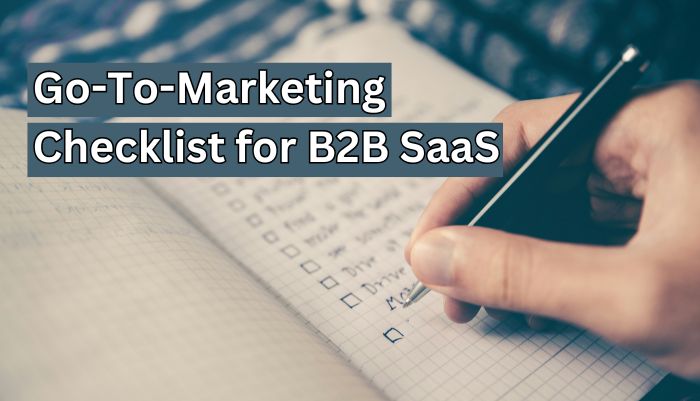Ultimate Go-To-Marketing Checklist for B2B SaaS
Summary
- Why is GTM Crucial for SaaS Startups?
- Go-to-Marketing Checklist for B2B SaaS
- Conclusion
A GTM or Go-to-Marketing Strategy helps SaaS reach your ideal customer.
A Go-to-marketing checklist ensures you reach fast and effectively.
Without any fuss, we are sharing the most in-depth Go-to-marketing checklist here.
So, without any ado, let’s get started right away.
Why is GTM Crucial for SaaS Startups?
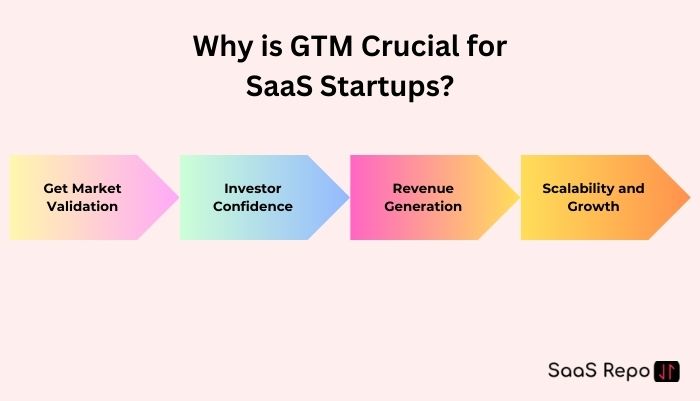
A Go-To-Market checklist is essential in more than just one way. It helps you and founding team:
- Get Market Validation: GTM helps you test whether their SaaS product aligns customers and gives them continuous value. GTM provides a structured approach to engage the target audience, optimize messaging, and check product demand in the real-world.
- Investor Confidence: If and when working with investors, a solid GTM boosts their confidence in the product as well as the team. It demonstrates that you understand the market and have a roadmap to achieve profitability.
- Revenue Generation: Bootstrapped or backed, startups need revenue quickly to sustain and grow. SaaS marketing strategy enables the identification of high-value customers, sales channels, and ways to convert prospects into paying users.
- Scalability and Growth: GTM strategies are the foundation stone for scaling. By identifying scalable marketing methods, you will be able to create a growth engine that sustains as the startup grows.
Go-to-Marketing Checklist for B2B SaaS
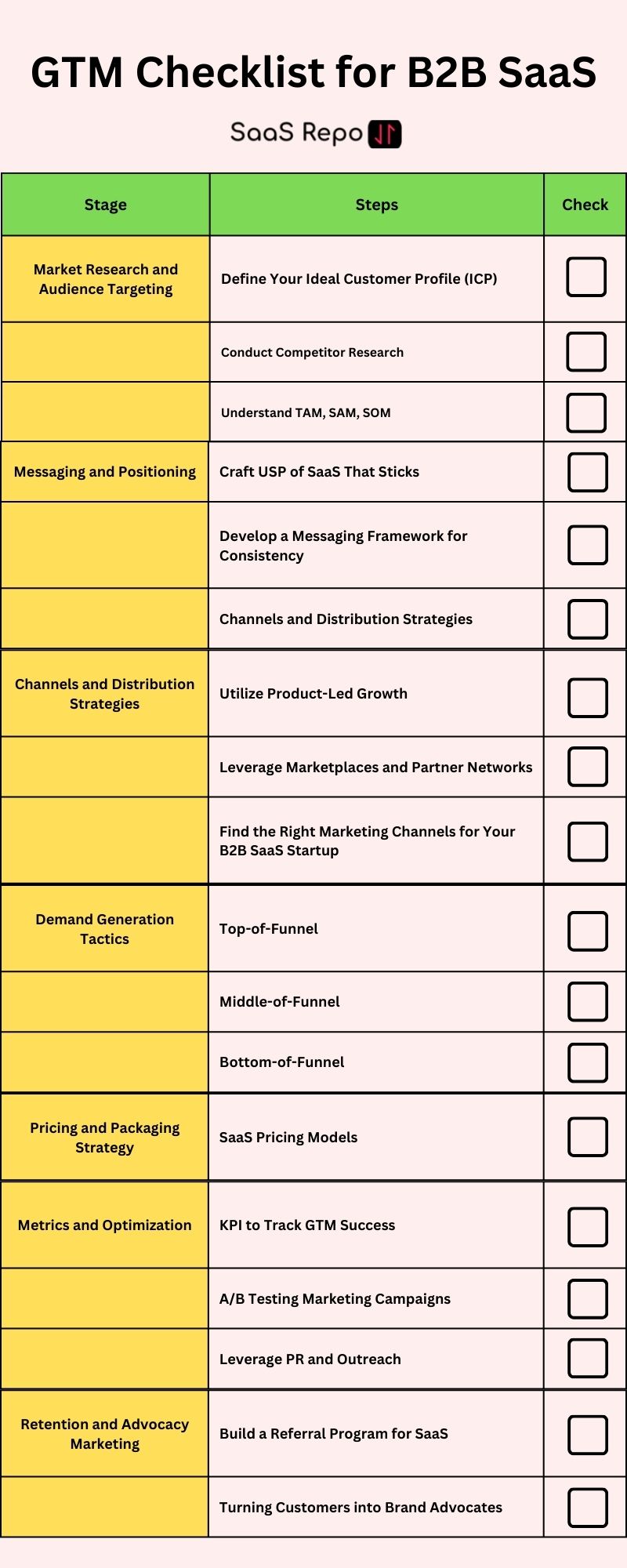
1. Market Research and Audience Targeting

The first stage of Go-to-marketing checklist is understanding the market and B2B users thoroughly. This stage involves understanding your market and defining who your product is for.
This will ensure that you focus on the right audience, are able outsmart competitors, and get a better understanding of B2B SaaS potential in the real world.
Define Your Ideal Customer Profile (ICP)
A well-defined ICP will prevent wasted efforts on leads that are unlikely to convert, but will take up resources.
Your Ideal Customer Profile (ICP) involves everything about the perfect customer of your B2B SaaS product.
Factors such as industry, company size, location, pain points, and goals. This will help your sales and marketing teams to target the right audience from day one.
Here’s what you have to do:
- Understand users of competitors and what proposition that value is. This can be pricing, workflow, specific tools, or anything else. Going through competitor reviews on Trustpilot or G2 can help.
- Validate your ICP by actually connecting with them. Early stage interviews, testing, and feedback can be highly valuable. You can use forums like Reddit to find interested candidates for beta testing in your niche.
Conduct Competitor Research
Understanding competitors will help you differentiate your product in the market. This might also help you identify unaddressed customers that your competitors might be overseeing. A unique advantage that you can utilize.
Here’s what you have to at this stage of Go-to-marketing checklist:
- Create a comparison chart of competitors’ products and strategies.
- Identify their strengths and weaknesses relative to your product.
- Look out for gaps in the market where your product can differentiate.
Understand TAM, SAM, SOM
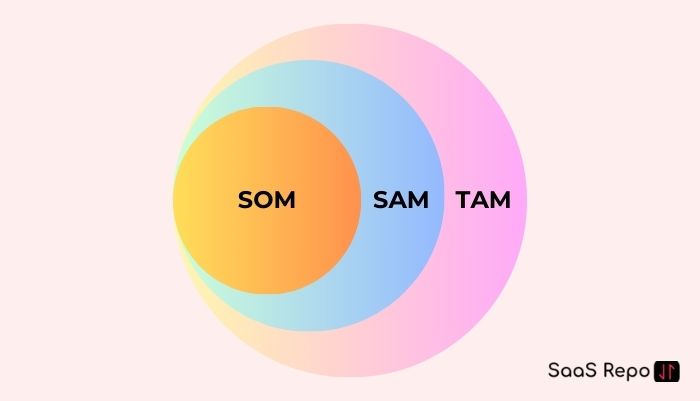
Here’s what TAM, SAM, and SOM means.
- TAM – Total Addressable Market
- SAM – Serviceable Available Market
- SOM – Serviceable Obtainable Market
TAM is the total market, SAM is the portion you can serve, and SOM is the market you can realistically capture.
Having a defined and realistic understanding is really important here. This would help you roughly calculate your customer acquisition cost, and channels you can utilize to grow effectively.
2. Messaging and Positioning
This stage of Go-to-marketing checklist is about defining how your product will be perceived in the market.
A strong messaging and positioning is really important for a B2B SaaS startup.
It creates a clear and compelling reason such that your target audience remembers who you are. More importantly, who are you competing with in the market.
Craft USP of SaaS That Sticks
Unique Selling Proposition (USP) is what makes your SaaS differentiates you from your competitors. It tells your customer who you are. For example:
- Are you the cheapest option?
- Are the most advanced and beginner friendly platforms?
- Are you the most viral product because of an ad?
- Or are you doing something that no one thought of?
Your USP highlights the specific benefit that only your product delivers. It showcases how your B2B SaaS solves a unique pain point for your ideal customer that only you care about.
Here’s what you can do here:
- Identify the primary benefit your SaaS offers that competitors do not.
- Align this benefit with the pain points and needs of your ICP.
- Refine the message to be concise, impactful, and easy to recall.
- Stick with and distribute your USP as much as possible.
Develop a Messaging Framework for Consistency
A consistent messaging framework ensures that your brand message is being heard. With clarity as well as directly associated with your brand.
For example, HubSpot messaging has always positioned itself as a powerful, but beginners friendly CRM for SaaS. This reflects in the marketing as well as every activity they do to reach their ICP.
Your messaging framework defines your core messages, benefits, and tone tailored to who you are speaking to. Is it a message for executives, managers, or end-users? It should be clear right away.
Here’s what you can do at this stage of B2B Go-to-marketing checklist for SaaS:
- Draft key messages for each audience segment.
- Focus on specific needs and priorities of different ICPs.
- Develop a consistent tone and style guide for all communications.
- Test and refine your messaging across different channels.
3. Channels and Distribution Strategies
At this stage of Go-to-marketing checklist, focus on finding most effective methods to reach your audience and communicate your message.
An optimized distribution will ensure that your SaaS reaches your target audience while maximizing ROI.
Utilize Product-Led Growth
In Product-led growth (PLG) startups emphasize on the SaaS product as the source of attention for customer acquisition, retention, and growth.
It reduces dependency on high-cost marketing efforts like influencer marketing and leverages customer satisfaction to fuel organic growth and virality. One of the best examples is ChatGPT.
Launched in November 2022, OpenAI acquired 1 million users in just 5 days. A rare and commendable fleet.
Here’s what you can learn and follow.
- Create a frictionless onboarding experience to highlight product value quickly.
- Offer free trials or freemium tiers with a clear upgrade path.
- Monitor user behavior and optimize users workflows to increase product adoption.
Leverage Marketplaces and Partner Networks
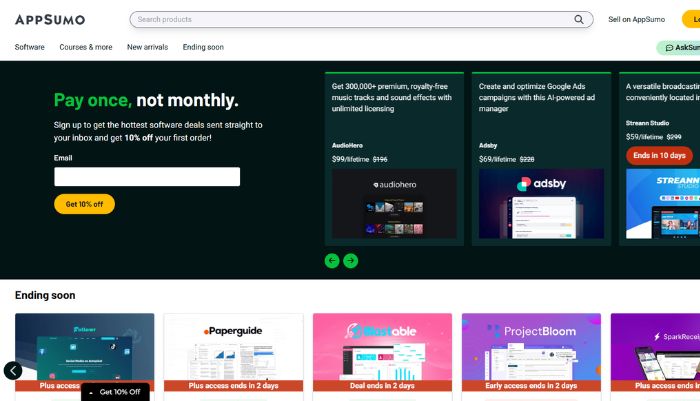
Marketplaces and Partner Networks like ProductHunt, AppSumo, App Stores, etc provide instant access to a broad audience.
These are people who might be actively seeking solutions and ready to try new solutions.
Partnering with established platforms and marketplaces can surely help you expand your reach and credibility.
Here are a few points to takeaway here.
- Identify marketplaces and networks relevant to your SaaS niche. Specifically based on your ICP.
- Optimize your product listings with compelling descriptions and reviews.
- Try creating co-marketing or referral partnerships with complementary products or services.
Find the Right Marketing Channels for Your B2B SaaS Startup
The right channels avoids resource wastage and ensures your message reaches the right decision-makers.
Identifying the most effective marketing channels early ensures that your efforts resonate with your target audience while maximizing returns.
We have already shared an extensive list of best SaaS marketing channels. Some of the most common SaaS marketing channels are content marketing, paid ads, webinars, or social media.
4. Demand Generation Tactics
At this stage of Go-to-marketing checklist, your goal is to convert your ideal prospects into customers. Attract them and then convince them. And this happens at different stages.
Demand generation focuses on creating interest and generating leads throughout the buyer’s journey.
These stages are
- Top-of-Funnel
- Middle-of-Funnel
- Bottom-of-Funnel
Let’s go over them to understand these stages better.
Top-of-Funnel
Top-of-funnel activities expand your reach and introduce your SaaS to new audiences.
This stage aims to build awareness and attract prospects who are just discovering your product or the problem it solves.
For TOF, some common tactics include blog posts, social media, webinars, and SEO.
Here’s how you can execute top-of-funnel marketing campaign:
- Create educational content that addresses common pain points of your ICP.
- Implement SEO to rank for high-intent keywords relevant to your SaaS.
- Run awareness campaigns through channels like LinkedIn and Google Ads.
Middle-of-Funnel
In Middle-of-funnel, you build trust and guide leads toward deeper consideration of your B2B SaaS product.
Here, the focus is on nurturing and educating prospects who are aware of their problem. Your goal here is to provide a solution.
This involves case studies, email campaigns, and product demos.
Here’s what you are can consider at this stage of go-to-marketing checklist:
- Develop resources like whitepapers, webinars, and comparison guides to showcase your product’s value.
- Set up email nurturing workflows to address common questions and objections.
- Offer live or recorded product demos to illustrate benefits.
Bottom-of-Funnel
A strong bottom-of-funnel converts prospects into customers by addressing final objections and emphasizing urgency. Here you capitalize on nurtured leads, increasing conversions and reducing churn.
Some common strategies for the bottom of the funnel include free trials, testimonials, and personalized follow-ups.
Some steps that you can take are:
- Provide social proof like testimonials, case studies, or reviews from satisfied customers.
- Offer free trials, discounts, or limited-time offers to encourage decisions.
- Use account based marketing to close deals.
5. Pricing and Packaging Strategy
Pricing and packaging are critical stages in driving revenue for your B2B SaaS product in the go-to-marketing checklist.
A clear strategy will not only attract the right customers but also help you maintain profitable growth.
This stage involves selecting the best pricing model for your product and creating a compelling pricing page that encourages conversions.
SaaS Pricing Models
A well-thought-out pricing model aligns with customer expectations. Common pricing models include subscription-based, tiered, usage-based, and freemium.
Each model impacts customer acquisition, retention, and growth differently. Hence, it becomes important to choose the best one for you.
Here are some quick notes on how you can choose the SaaS pricing model.
- Research your competitors’ pricing models and evaluate which works best for your target audience.
- Select a model that fits your product’s value and usage patterns—subscription or pay-per-use.
- Regularly test and adjust pricing based on customer feedback and market conditions.
6. Metrics and Optimization
Tracking the right metrics and continuously optimizing your strategies are key to ensure a successful stricking this step from Go-To-Market checklist.
By measuring performance and refining tactics, you’ll increase your chances of achieving long-term growth and profitability.
Here’s what you should add in your Go-to-market checklist for b2b SaaS:
KPI to Track GTM Success
Key Performance Indicators (KPIs) are metrics that measure the effectiveness of your strategy and go-to-marketing checklist. They allow you to make data-driven decisions to maximize efficiency and growth.
These could include customer acquisition cost (CAC), lifetime value (LTV), churn rate, conversion rates, and sales growth. Tracking KPIs helps you understand whether you’re on track to meet your business goals.
Here’s what is recommended at this stage:
- Identify the most important KPIs for your SaaS business (e.g., CAC, LTV, churn rate).
- Set clear benchmarks for each KPI, keeping in mind your goals for growth and profitability.
- Use reliable analytics tools to track these KPIs consistently and adjust your strategy as needed.
A/B Testing Marketing Campaigns
A/B testing involves comparing two variations of a marketing campaign to see which performs better.
It helps you optimize your campaigns for higher engagement and conversion rates, ensuring your marketing efforts are as effective as possible.
This could be testing email subject lines, ad copy, landing pages, or CTAs. A/B testing provides direct feedback on what resonates most with your audience.
Here’s what you have to do here:
- Choose one element of your campaign to test (e.g., email subject line, CTA button).
- Split your audience evenly between the two versions.
- Analyze results and apply insights to improve future campaigns.
Leverage PR and Outreach
Strategic PR and outreach can rapidly elevate your brand’s presence and attract new customers through third-party endorsements and high-quality backlinks.
These outreach efforts include gaining media coverage, building relationships with industry influencers, and securing guest posts.
Here are few things you can add in your go-to-market checklist as well:
- Identify key industry journalists, bloggers, and influencers to reach out to.
- Craft compelling press releases or pitch emails that highlight the unique value of your SaaS product.
- Build relationships with media outlets and consider opportunities for guest posts or podcast interviews.
7. Retention and Advocacy Marketing

Retention is critical for SaaS growth. The goal is to not only keep customers happy but also turn them into loyal advocates of your SaaS product.
That’s how you organic growth and build long term advocacy.
Build a Referral Program for SaaS
A referral program incentivizes your existing customers to recommend your SaaS product to others.
This act of referral can be further accelerated by offering rewards like discounts, credits, or exclusive features. The goal is to encourage happy customers and to spread the word, effectively creating a viral loop.
Here’s what you can add to your Go-to-marketing checklist
- Make the referral process simple and easy, ideally integrated into the product.
- Set clear, attractive rewards for both the referrer and the new customer.
- Promote your referral program across email, in-app messages, and on your website to encourage participation.
Turning Customers into Brand Advocates
Brand advocates build trust and influence in the industry. When your loyal customers talk about you, they are the best endorsements for your brand.
It involves engaging your best customers in your growth efforts, turning them into vocal supporters. Their influence is often more persuasive than traditional marketing, helping to attract new prospects and build long-term relationships.
Here’s what you can do:
- Identify your happiest, most loyal customers who are likely to advocate for your brand.
- Engage with them regularly to foster relationships—consider offering exclusive access to new features or events.
- Encourage them to leave reviews, share their success stories, and participate in case studies or testimonials.
Conclusion
Creating a successful Go-to-Market checklist for your B2B SaaS business is no small feat. It is one of the most crucial steps for sustained growth.
By following this comprehensive checklist that covers everything—from market research, messaging, channel strategies, pricing, and advocacy marketing—you’ll be well-equipped to reach your ideal customers.
Remember, a GTM strategy isn’t static. Continuously track metrics, refine your tactics, and engage with your customers to stay ahead in a competitive market.
With the right approach, your SaaS product can become the go-to solution for your target audience.

